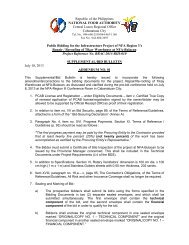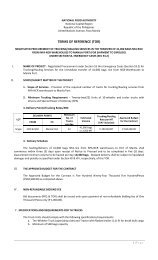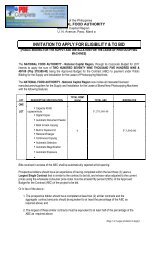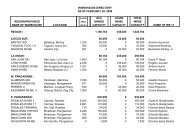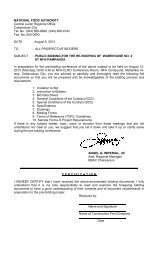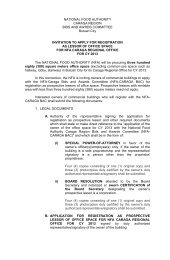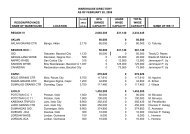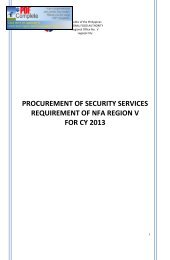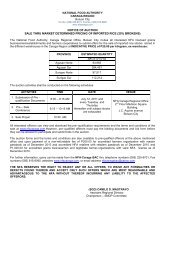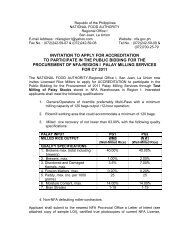Word Pro - Design & Development of DCS for Batch Recirculating ...
Word Pro - Design & Development of DCS for Batch Recirculating ...
Word Pro - Design & Development of DCS for Batch Recirculating ...
You also want an ePaper? Increase the reach of your titles
YUMPU automatically turns print PDFs into web optimized ePapers that Google loves.
NATIONAL FOOD AUTHORITY<br />
Quezon City<br />
DESIGN AND DEVELOPMENT<br />
OF DUST CONTROL SYSTEM FOR<br />
NFA BATCH RECIRCULATING DRYERS<br />
by<br />
Engr. JULIUS B. SUGUE<br />
Food Technologist II<br />
Engr. DIOCANO D. ALOJADO, JR.<br />
Assistant Division Chief, TRD<br />
Engr. DANILO G. NATIVIDAD<br />
Research Analyst II<br />
Engr. MA. ELVIRA M. MARTINEZ<br />
Division Chief, TRD<br />
Prepared by<br />
Technical Research Division<br />
Technology Resource <strong>Development</strong> Department<br />
Quezon City<br />
2002
Republic <strong>of</strong> the Philippines<br />
NATIONAL FOOD AUTHORITY<br />
Quezon City<br />
NATIONAL FOOD AUTHORITY MONITORING SYSTEM<br />
REPORT FOR COMPLETED RESEARCHES<br />
PART I. BASIC INFORMATION<br />
1. Research Title DESIGN AND DEVELOPMENT OF DUST<br />
CONTROL SYSTEM FOR NFA BATCH<br />
RECIRCULATING DRYERS<br />
2. Researchers Engr. Julius B. Sugue<br />
Engr. Danilo G. Natividad<br />
Engr. Diocano D. Alojado, Jr.<br />
Engr. Ma. Elvira M. Martinez<br />
3. Agency Involved National Food Authority<br />
Technology Resource <strong>Development</strong> Department<br />
Technical Research Division<br />
4. Research Sites NFA, Nueva Ecija Branch Office<br />
5. Funding Agency/Amount National Food Authority/ P<br />
6. Duration<br />
6.1. Date Started August 2001<br />
6.2. Date Ended November 2001<br />
7. <strong>Development</strong> Zone Facility <strong>Development</strong><br />
8. Technology Level Grain Post Harvest Technology
PART II. TECHNICAL REPORT<br />
TITLE<br />
ABSTRACT<br />
DESIGN AND DEVELOPMENT OF DUST CONTROL SYSTEM<br />
FOR NFA BATCH RECIRCULATING DRYERS 1/<br />
by<br />
Engr. Julius B. Sugue, Engr. Danilo G. Natividad,<br />
Engr. Diocano D. Alojado, Jr., and Engr. Ma. Elvira M. Martinez 2/<br />
<strong>Design</strong> and development <strong>of</strong> the prototype Dust Control System (<strong>DCS</strong>) was undertaken from<br />
August to November 2001. Fabrication was done in NFA, Nueva Ecija branch <strong>of</strong>fice with the<br />
direct assistance <strong>of</strong> personnel in the Technical Services Section. The unit was installed and<br />
integrated in one batch recirculating dryer located at warehouse # 4 <strong>of</strong> Cabanatuan Grain<br />
Center. The <strong>DCS</strong> that was developed is targeted to complement NFA’s batch recirculating<br />
dryers. The study aimed to design and develop a <strong>DCS</strong> appropriate to NFA batch recirculating<br />
dryer installations. It was designed to be simple, easy and requires less labor to operate. The<br />
system was tested mainly to determine its dust control per<strong>for</strong>mance and advantages in drying<br />
operation. These include the evaluation <strong>of</strong> the appropriate locally available sprayer nozzle<br />
that can produce enough water droplets that can able to scavenge impurities and fugitive<br />
(respirable) dust particles out from drying air. It was observed during the testing that the <strong>DCS</strong><br />
developed was effective to draw large impurities and dust particle out from the drying air.<br />
The impurities were filtered by the mist introduced in the system. Although some technical<br />
problems occurred during the testing, it was noted that the dust control system developed was<br />
effective in collecting impurities and controlling fugitive dust during drying.<br />
After the evaluation, it is recommended that further testing and evaluation <strong>of</strong> the developed<br />
<strong>DCS</strong> shall be undertaken to intensively evaluate and assess the needed modification and<br />
improvement <strong>of</strong> the prototype be<strong>for</strong>e effecting the final reproduction.<br />
1/ A research project conducted by the Technology Resource <strong>Development</strong> Department <strong>of</strong> the<br />
National Food Authority from August to December 2001.<br />
2/ Food Technologist II, Research Analyst II, Assistant Division Chief, and Division Chief<br />
respectively Technical Research Division, Technology Resource <strong>Development</strong><br />
Department, National Food Authority<br />
1
B. PROJECT DETAILS<br />
I. TITLE : DESIGN AND DEVELOPMENT OF DUST CONTROL<br />
SYSTEM FOR NFA BATCH RECIRCULATING<br />
DRYERS<br />
II. PROPONENT : Technical Research Division<br />
Technology Resource <strong>Development</strong> Department<br />
National Food Authority<br />
III. RATIONALE<br />
Dust pollution is common to our ricemills, dryers and bulk handling facilities. This poses<br />
health hazard not only to our own personnel but also to nearby residential communities. If<br />
not properly addressed, this will surely create serious problems that will eventually peril<br />
our different grain’s postharvest operation. In some cases the problem <strong>of</strong> dust emissions<br />
emanating from our grains processing facilities caused serious environmental and legal<br />
problems. Some field <strong>of</strong>fices were already legally sanctioned by proper government<br />
authorities.<br />
Originally, most <strong>of</strong> NFA warehouses were designed purposely <strong>for</strong> grain storage. With the<br />
continuous acquisition <strong>of</strong> various post harvest facilities particularly mechanical grain<br />
dryers NFA warehouses now are used as grain storage and processing centers. During the<br />
past years dust control programs were not given enough attention. Due to the intensified<br />
milling and drying operations, these have became increasingly necessary. Some <strong>of</strong> NFA<br />
facilities were installed with accompanying dust control system/ dust collection<br />
accessories but in most cases ineffective, or much worse non-functional, due to poor<br />
maintenance.<br />
With the given scenario and concern there is a need to urgently solve the problem<br />
common to all NFA batch recirculating dryers. The study aims to design and fabricate a<br />
prototype dust control system that will eventualy arrest and eliminate the problem <strong>of</strong> dust<br />
pollution.<br />
2
IV. OBJECTIVES<br />
1. To develop a Dust Control System (<strong>DCS</strong>) that will eventually reduce or eliminate dust<br />
pollution in the operation <strong>of</strong> <strong>Batch</strong> <strong>Recirculating</strong> Dryers (BRD).<br />
2. To fabricate a prototype <strong>DCS</strong> <strong>for</strong> NFA’s batch recirculating dryers.<br />
3. To test and evaluate the technical appropriateness <strong>of</strong> the prototype in relation to NFA<br />
drying operation.<br />
V. MATERIALS AND METHODS<br />
A. Materials<br />
Plain GI Sheet (gauge #26) Flat Bar (1/8” x 1” x 20 ft.)<br />
Brass Extension tube Hose Clamp<br />
Agricultural Sprayer Nozzle Water Hose 8 mm diameter<br />
Hose fitting Power Sprayer<br />
Other Material used<br />
Plastic Drum Blind rivets (1/8 and 3/16)<br />
Hand Riveter Drill Bit<br />
Tread Seal Tape Welding Rod<br />
Capscrew and Washer (1/4 x 1”) Tie wire<br />
Acetylene Sealant<br />
B. Methods and <strong>Pro</strong>cedures<br />
1. <strong>Design</strong> and <strong>Development</strong><br />
Based on the requirement <strong>of</strong> existing NFA owned batch recirculating dryers, a prototype<br />
<strong>of</strong> the system has been developed. It was made <strong>of</strong> locally available materials, and it was<br />
fabricated without requiring high-tech facilities.<br />
The system composed the following main components:<br />
a. Vertical Dust Stack - This is a cylindrical metal tube made to confine air and dust<br />
mixture from the dryer. The stack was made <strong>of</strong> five (5) cylinders with 2.50 ft.<br />
diameter and 4 ft. in height. The cylinders were bolted together <strong>for</strong>ming a 20 feet long<br />
single vertical stack. Each cylinder was provided with 10 inches square window to<br />
serve as an access in cleaning and adjusting the sprayer nozzle during and/or after<br />
operation. The five cylinders were made <strong>of</strong> plain GI sheet (gauge #26). To add<br />
stiffness in <strong>for</strong>ming the cylinders, a flat bar was welded and riveted in the opposite<br />
end <strong>of</strong> it. Sealant was applied to all joints and overlaps <strong>of</strong> the stack to avoid leakage<br />
during operation.<br />
3
. Mist Sprayer - Four agricultural sprayer nozzles <strong>of</strong> different sizes were used to<br />
produce a water mist inside the dust stack. They were strategically positioned inside<br />
the cylinder. They were located at 4 ft. interval beginning from the lowest cylinder.<br />
The two lower nozzles were designed to produce a very fine mist spray while the<br />
other two upper nozzles were designed to deliver larger spray particles. All nozzles<br />
were directed downward to produce densely packed fog droplets inside the stack.<br />
Linking the four nozzles and the power sprayer is an 8 mm water hose. Each set <strong>of</strong><br />
nozzle was connected to a discharge outlet <strong>of</strong> the power sprayer.<br />
c. High Pressurize Water Sprayer - One unit <strong>of</strong> electrically operated power sprayer was<br />
used to supply and deliver pressure in the system. The unit can produce a maximum<br />
pressure <strong>of</strong> 40 kg/cm 2 and a maximum discharge <strong>of</strong> 25 L/min.<br />
d. Water Lines - An 8 mm diameter water hose was used to linked the nozzles and the<br />
power sprayer.<br />
e. Hood - Two (2) hoods are located in the lowest cylinder to linked the fan exhaust and<br />
aspirator <strong>of</strong> the dryer with the vertical dust stack. The hoods were designed to project<br />
downward flow <strong>of</strong> air and impurities exiting from the dryer. This allowed a lesser<br />
upward velocity impact <strong>of</strong> air exiting from the dryer exhaust.<br />
f. Baffles and Overhead Cap - Three (3) baffles were placed inside the dust stack to<br />
provide greater surface impact <strong>of</strong> dust and air coming out from the dryer exhaust. A<br />
conical overhead cap was positioned on the topmost portion to limit the spread <strong>of</strong> air<br />
exiting from the dust stack.<br />
2. System Integration<br />
The dust control unit was made integral to the whole drying system <strong>of</strong> the existing batch<br />
recirculating dryer. The DC unit was connected to the dryer exhaust. It was installed<br />
outside the warehouse.<br />
3. Fabrication and Installation<br />
a. Fabrication and installation was done in NFA, Nueva Ecija Branch Office. It was done<br />
through the assistance <strong>of</strong> TSD field personnel. Fabrication was undertaken without<br />
requiring hi-tech equipment. Connection and joints were made by the use <strong>of</strong> simple<br />
acetylene and electronic welding, capscrew and blind rivets. The fabricated unit was<br />
integrated to one batch recirculating dryer in the area.<br />
4. Test and Evaluation<br />
Testing was conducted using dried palay. During the evaluation, three levels <strong>of</strong> test were<br />
made, namely; mist capacity test, dust control per<strong>for</strong>mance and operational evaluation <strong>of</strong><br />
the prototype.<br />
4
a. Mist Capacity Test<br />
The system was tested to determine the appropriate mist capacity that is effective in<br />
knocking down fugitive (respirable) dust during drying. Technically, it is difficult to<br />
impact micron-size dust particles that is why the existing designs (using inertial<br />
separation) are ineffective in controlling dust pollution. By the introduction <strong>of</strong> water<br />
droplets where size is comparable to the size <strong>of</strong> dust particle, there is a greater chance<br />
to control dust pollution. When fine droplets are sprayed inside the dust stack,<br />
adherence and contact occurred between water droplets and dust particles until the<br />
droplets grows to critical size and it will gravitate. It is important to produce densely<br />
pack fog droplets inside the dust stack so that the dust particles have a little or no<br />
chance <strong>of</strong> escaping. It was observed during the test that, fine mist were more effective<br />
in knocking down dust particles only, some were blown or carried out from the stack<br />
due to the high airf velocity <strong>of</strong> exhaust fan <strong>of</strong> the dryer. It was further noted that the<br />
four nozzles (1 set mist spray nozzle and 1 set fine spray nozzle) used during the<br />
testing were enough to draw out large impurities and dust particle from the drying air.<br />
b. Dust Control Per<strong>for</strong>mance<br />
During the test and evaluation, drying was done without the use <strong>of</strong> the <strong>DCS</strong> prototype.<br />
It was noted that dust particles and large impurities were freely suspended, scattered in<br />
the drying place. It can be described that distance traveled by the impurities and<br />
respirable dust particles were greater without using the prototype It is sad to note that<br />
considerable amounts <strong>of</strong> dust were carried through the nearby communities. By the<br />
integration <strong>of</strong> the prototype in the drying operation, it was observed that dust pollution<br />
was minimized. The <strong>DCS</strong> has a high potential to eliminate dust pollution especially<br />
those fugitive (respirable) dust that the existing designs (inertial separation) could not<br />
able to collect. Mist spray was observed effective in knocking large and small dust<br />
particles out <strong>of</strong> the drying air. It was further observed that the suspension time <strong>of</strong> the<br />
dust particles and its spread in the nearby surroundings was limited. (Please see<br />
attached documents).<br />
C. Operational Evaluation<br />
The system needs one labor to operate the prototype. The labor can be the dryer<br />
operator himself. Operating the <strong>DCS</strong> is simple. During drying, just turn on the water<br />
and electric supply to start the system. Droplet size can be adjusted through regulating<br />
the pressure produced by the power sprayer. Droplet size decreases as the pressure<br />
increases. Water discharge can also be controlled by regulating the pressure supplied<br />
by the power sprayer (maximum discharge 25 L/min). In one aspect however, the<br />
material (GI sheets and flat bar) used to fabricate the dust control unit was observed to<br />
be inappropriate (thin). It might not last long at continuous drying operation. During<br />
operation, small and large impurities were deposited at the base <strong>of</strong> the dust stack.<br />
Since the system was observed to have minimal water consumption, the slurry<br />
produced (mixture <strong>of</strong> fine dust particle and water) were allowed to flow in the<br />
drainage canal.<br />
5
VI. RESULTS<br />
The following pictures will demonstrate the per<strong>for</strong>mance <strong>of</strong> the prototype Dust Control<br />
System:<br />
Figure 1 Figure 2 Figure 3<br />
Pictures showing the pollution produced during drying operation. Figure 1 shows the<br />
dust particles were blown or carried out from the dryer by the exhaust fan. Figure 2 & 3<br />
shows the escape <strong>of</strong> fugitive (respirable) dust particles from the dust stack. Dust<br />
particles were freely suspended and scattered in the environment. In the picture, the<br />
<strong>DCS</strong> was already connected with the dryer exhaust but water sprays were not yet<br />
introduced.<br />
6
Figure 4 Figure 5 Figure 6<br />
Pictures showing the dust control per<strong>for</strong>mance <strong>of</strong> the prototype. In this stage water<br />
sprays were already introduced in the system. The dust pollution (pls. See previous<br />
picture) produced during drying was eliminated with the integration <strong>of</strong> the prototype<br />
<strong>DCS</strong>.<br />
7
VII. CONCLUSION AND RECOMMENDATIONS<br />
The ineffective and much worse absence <strong>of</strong> dust control system <strong>of</strong> NFA drying facilities<br />
posed problems on dust pollution. The intensified drying operation <strong>of</strong> the agency worsen<br />
the situation. Directly affected by this issue is our grain processing operation, the nearby<br />
community and the personnel in our grain processing centers. It is known that dust<br />
particle (silica) from palay can contribute to health related problems. Even the agency’s<br />
good warehouse keeping program, clean and green program, etc. were threatened by<br />
ineffective dust control system. To give a solution to these problems, the study was<br />
developed. The study aimed to design and develop a <strong>DCS</strong> appropriate to NFA batch<br />
recirculating dryer installations. It was designed to be simple, easy and requires less<br />
labor in its operation. This was tested and evaluated to determine its dust control<br />
per<strong>for</strong>mance and advantages in drying operation. After the test and evaluation, it was<br />
proven that the <strong>DCS</strong> developed is effective in controlling dust pollution in the operation<br />
<strong>of</strong> batch recirculating dryer. It is there<strong>for</strong>e, concluded that the objectives <strong>of</strong> the project<br />
were achieved.<br />
However, based on the <strong>for</strong>egoing result <strong>of</strong> testing and evaluation, the following are<br />
recommended;<br />
1. The vertical dust stack should be made <strong>of</strong> more rigid and durable materials.<br />
2. To include in the design the best method in disposing the slurry (mixture <strong>of</strong> waster,<br />
impurities and dust) during drying operation.<br />
3. To conduct further test and evaluation <strong>of</strong> the prototype to come up with established<br />
data on the required mist capacity, water consumption and dust control efficiency <strong>of</strong><br />
the system.<br />
4. A series <strong>of</strong> actual/field testing be undertaken to evaluate the actual per<strong>for</strong>mance <strong>of</strong><br />
the prototype.<br />
5. To consider in the design how to diffused the upward velocity impact <strong>of</strong> the drying<br />
air to avoid the escape <strong>of</strong> mist in the stack without affecting the drying per<strong>for</strong>mance<br />
<strong>of</strong> the dryer.<br />
8
<strong>DCS</strong> SET-UP<br />
Picture showing the actual set-up <strong>of</strong> the <strong>Pro</strong>totype Drawing showing parts and<br />
In warehouse #4 <strong>of</strong> Cabanatuan Grain Center accessories <strong>of</strong> the <strong>Pro</strong>totype<br />
9<br />
Drying<br />
Air Exhaust<br />
Dryer Aspirator<br />
Exhuast<br />
Warehouse Wall<br />
Aspirator Hood<br />
Water receptacle<br />
Hood<br />
Base<br />
Overhead Cap<br />
Dust Stack<br />
Fine Spray Nozzle<br />
TEE Joint<br />
Fine Spray Nozzle<br />
Baffle<br />
Water Hose<br />
Mist Spray Nozzle<br />
Window<br />
Mist Spray Nozzle<br />
Power Sprayer
PICTORIALS<br />
Pictures showing the researcher during the conduct <strong>of</strong> the study.<br />
10




